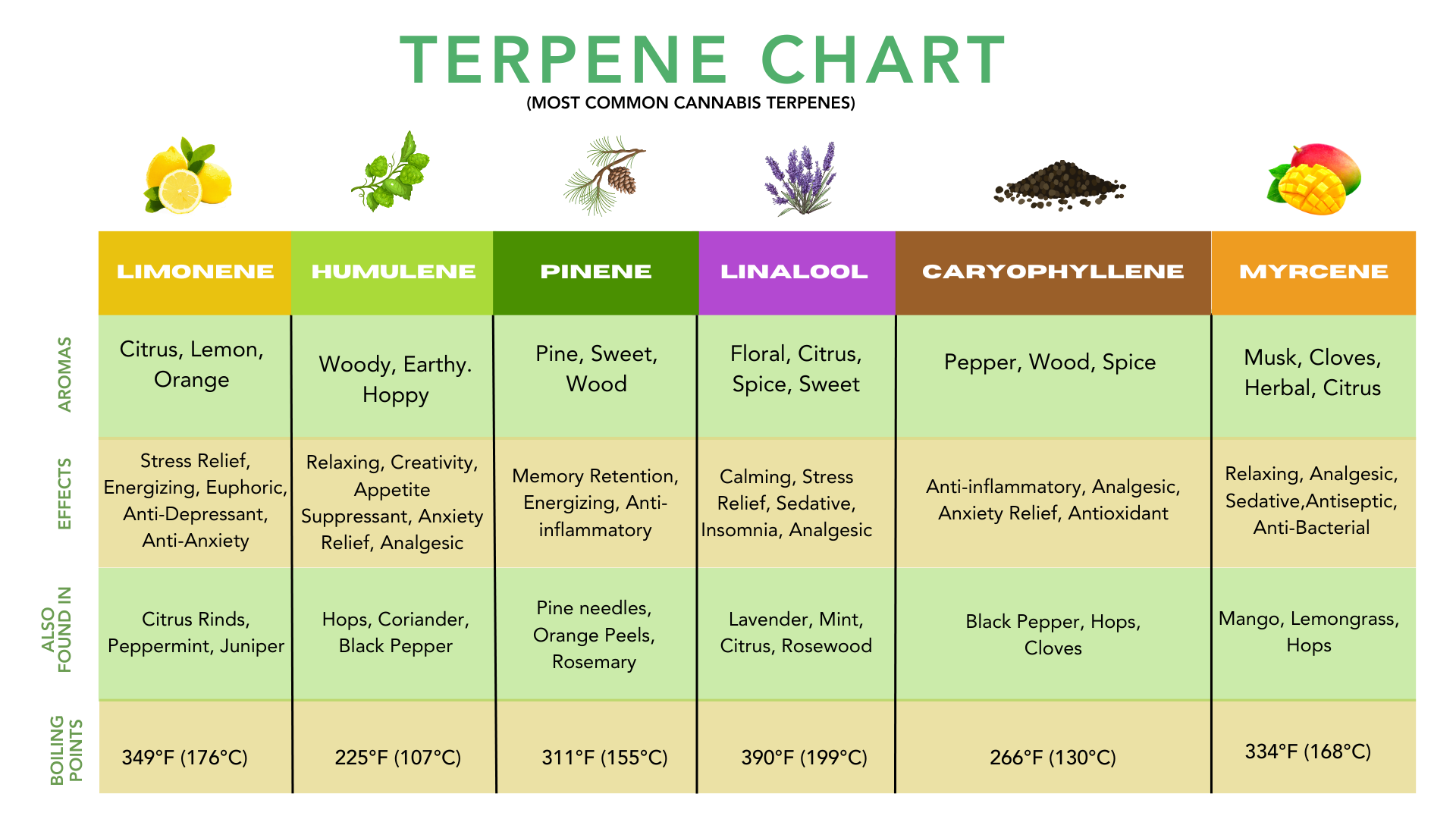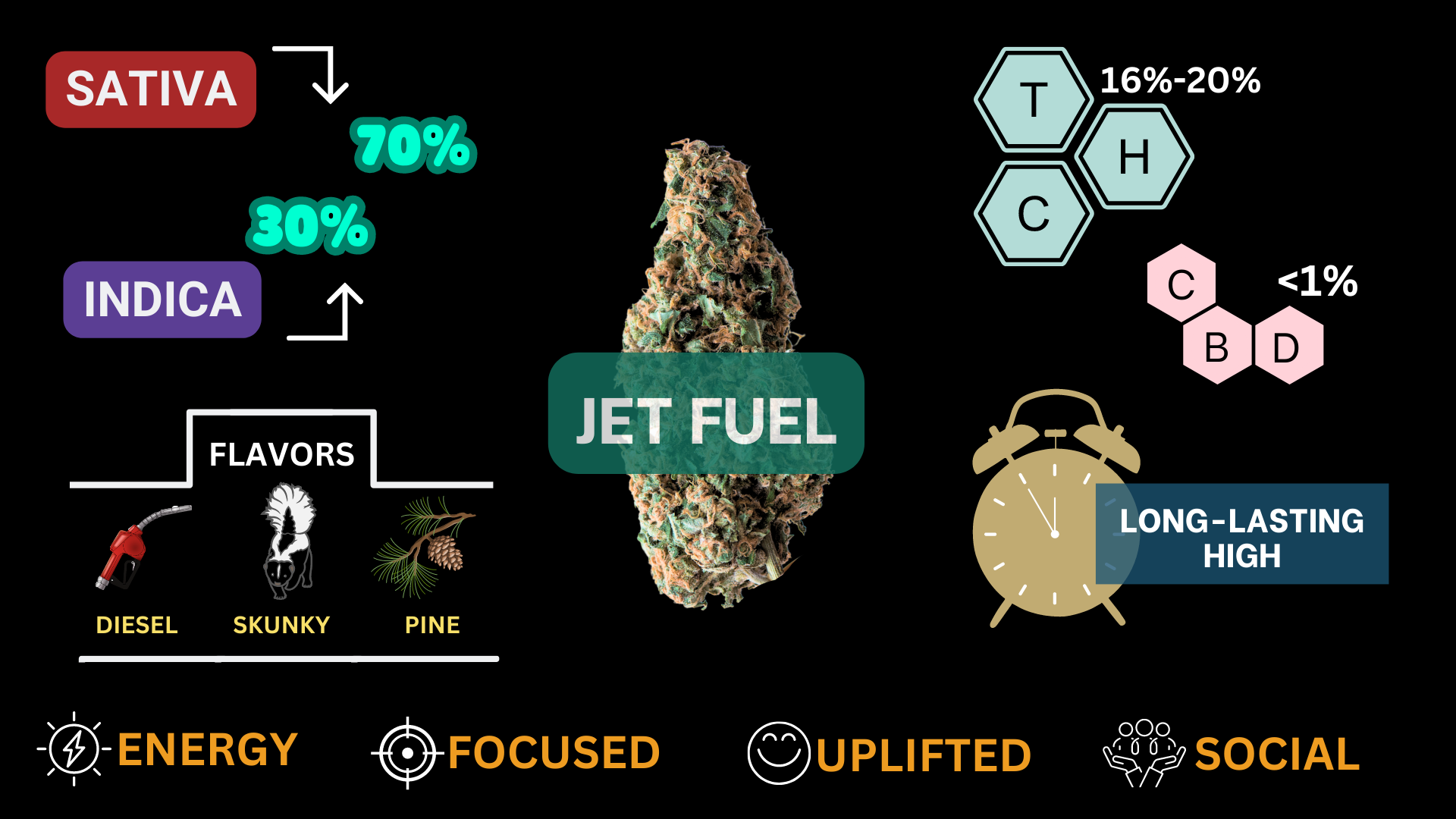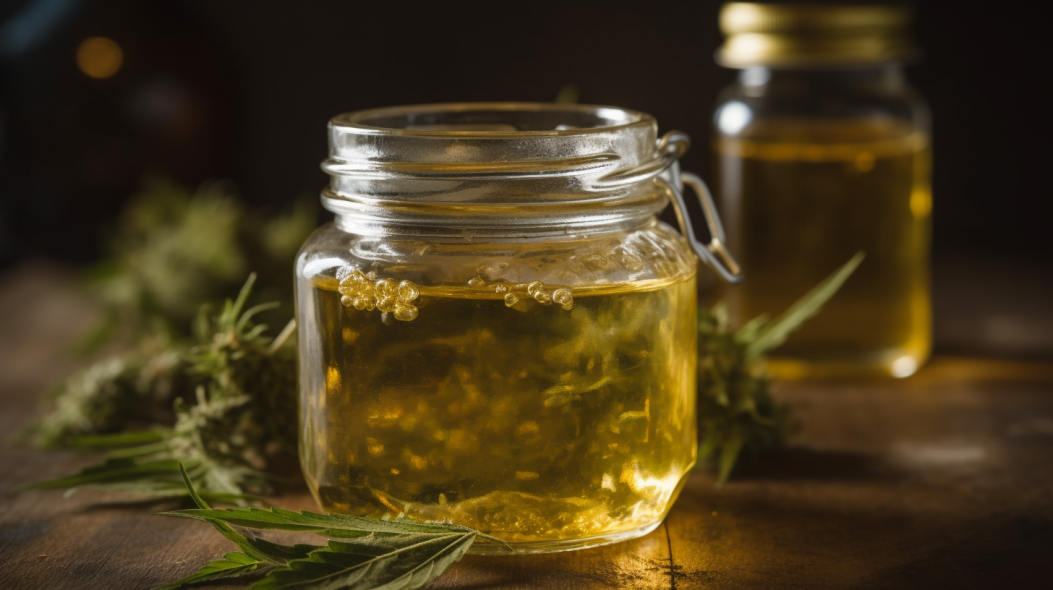Jet Fuel Strain:Cannabis Guide

Jet fuel, also known as "G6", "Jet Fuel OG", "Jet Fuel G6", "Jet Fuel Kush", "G6 Kush" is a hybrid strain that is known to bring you uplifted feelings and relieves your stress and anxiety. This is one high-flying experience for marijuana enthusiasts. A sativa-rich marijuana strain known for its euphoric and energizing effects. It offers a unique blend of aromatics, including gasoline/diesel, skunk, pine aroma with a sweetness mixed in.
THC and CBD Content
Most Jet Fuel strains have a THC content of 16% to 20% with the average Jet Fuel marijuana strain having 17%. Even with the average THC percentages this strain still gives powerful effects. The CBD levels typically below 1% and on average is about 0.2% CBD. With such low percentages of CBD it helps boost the power of the THC by allowing you to receive more psychoactivity and this is because the higher the CBD percentages the more psychoactivity from the weed thats blocked from your brain's CB1 receptors.
Genetic Background and Origin
Breeding History
Jet Fuel OG strain was created by 303 Seeds in Colorado. An ultimate cross combining Aspen OG and High Country Diesel. This hybrid is predominantly sativa with about 30% indica content. It definitely is a known diesel strain by marijuana lovers.
Parent Strain #1: Aspen OG
Aspen OG is another strain that was created by 303 Seeds and is a hybrid. It was created by the crossings of Sour Cream and SFV OG. The hybrid averages about 60% sativa and 40% indica but with some varieties the sativa can go up to 70-90%. It typically is known to give you powerful effects of focus, and uplifting effects and will make you quite chatty. You may also feel a boost in creativity, euphoria, happy and expect to get the munchies. Flavors of Aspen OG are spicy, herbal, nutty and woody and aromas of floral and sweet. The main terpenes are Limonene, Caryophyllene and Humulene.
Parent Strain #2: High Country Diesel
High Country Diesel is a dominant indica strain at 70% and 30% sativa. This is another ultimate cross between Diesel and OG Kush cannabis strains. Its THC percentages average from 13-17%. Some of the effects you can expect are a body high, relaxing, tingly, uplifting and definitely sleepy. It gives a good balance of effects from both the sativa and indica side. The Flavors in this diesel is well of course, diesel, with hints of herbal, spicy and sweet. The aromas you may get are Diesel, Earthy, Sweet and a Pungent aroma. The main terpenes in this plant is Borneol and Limonene.
Flavor and Aroma Profile
Dominant Scents
Well, just as its name suggests, it has a strong diesel aroma that some may say that it is a nice reminiscent of OG Kush. This has a very pungent aroma and gas-like smell that is rather strong notes hard to cover and disguise. It is also noted that consumers may get smells of pine, wood, skunk and subtle hints of sweetness.
Taste Experience
Often times the flavor profile will parallel the aroma profile. The main flavors is a pungent aroma, diesel, pine and sweet taste. Though, you may get tastes of skunky, lemon, pine, and black pepper flavors. The main terpenes are Myrcene, being the dominant terpene, followed by Pinene, Humulene, Caryophyllene and Limonene. Cannabis terpenes have a strong part in why the flower may smell and taste the way that it does. As you can see on the visual below, these terpenes have their own flavor/aroma profile that adds in and mixes creating the strains profile. Some flavors and smells may be more prominent then others.

Effects and Benefits
As mentioned above, the terpenes within this plant have an effect on the flavor and aroma profile of Jet Fuel strain but that is not all. The chart also shows what kind of effects and medical benefits that each terpene has and they can also come through and play a role in the effects and benefits of the jet fuel strain itself. Those terpenes can impact the way the THC effects you and in cases can strengthen or weaken a effect.
Energizing and Uplifting
This is definitely a strain to wake you up and get you going. It is ideal for daytime use and creative endeavors. Promoting alertness, focus, and concentration. The strain also gives you feelings of happiness, uplifting effects, energy and light relaxation. It also gives you a cerebral high that is enjoyable. The high will get you giggly but will give your body a nice euphoric high. The high may start as a relaxed head buzz but then the energy and uplifting effects kicks in, making this better to smoke in the morning and day and wouldn't be recommended to help your insomnia.

Medical Benefits
It is known to help alleviate stress, anxiety, depression, Bipolar Disorder and chronic fatigue. Smoking or consuming it will make you rather hungry it could also support in aiding anorexia. It is also beneficial for tension headaches and migraines. With the analgesic properties in the terpenes it is good for pain relief and chronic pain relief.
Like any strain, there are potential side effects to look out for. Some of those may be the risk of paranoia and anxiety, especially for inexperienced users. This is also a common side effect of sativa strains. You may also get dry mouth, dry eyes, anxious and or dizzy.
Growing the Jet Fuel Strain
Jet Fuel, known for its uplifting and potent effects, is a favorite among many marijuana cultivators and enthusiasts. If you're thinking about growing this strain, here's a broad overview of what to expect:
Indoor Cultivation: The Ideal Environment for Jet Fuel
While Jet Fuel can be grown indoors or outdoors, it particularly thrives in controlled indoor environments. The sensitivity to external factors makes an indoor setup beneficial:
1. Temperature and Humidity Control: Jet Fuel prefers stable temperatures, ideally between 68°F to 77°F (20°C to 25°C). Humidity levels should start higher during the vegetative stage and eventually level should be reduced during flowering to optimize bud development and prevent mold.
2. Protection from the Elements: Indoor cultivation shields from unpredictable weather patterns, ensuring a consistent and healthy growth cycle.
Growth Patterns and Flowering
Jet Fuel showcases some distinctive growth characteristics:
Flowering Duration: Typically, Jet Fuel flowers within about nine weeks, a relatively short period for its sativa dominance.
Height: Jet Fuel is notable for its vertical growth. Even in indoor setups, with the right care and conditions, it can achieve heights nearing 10 feet. Proper training techniques can help manage its stature.
Harvesting Insights
The quality of your Jet Fuel crop can be significantly enhanced with the right harvesting techniques:
1. When to Harvest: Although October is a general guideline for harvesting, it's crucial to monitor the trichomes on the buds. A mix of milky white and some amber trichomes indicates the plant is ready for harvest.
2. Drying and Curing: After harvesting, the buds should be dried in a dark, ventilated space. Once dried, they should be cured in airtight containers, a process that can take several weeks. Proper curing enhances both the flavor and potency of the strain.
Conclusion
Jet Fuel, often referred to by various names like "G6" or "Jet Fuel OG", stands out as a remarkable hybrid in the 420 community. Its unique aromatic blend, characterized by gasoline undertones mixed with pine and sweetness, offers users an invigorating and euphoric experience. With a THC content that can reach up to 20%, its effects are potent, making it a sought-after choice for both recreational and medicinal users.
Its lineage, stemming from the combining Aspen OG and High Country Diesel strains, further solidifies its reputation in the cannabis community. Cultivators are drawn to Jet Fuel's name not just for its effects and flavor profile but also for its growth characteristics. While it can reach impressive heights and has specific cultivation needs, the rewards, in terms of yield and quality, are well worth the effort. Whether you're consuming or growing, Jet Fuel's name promises an experience that's both uplifting and deeply satisfying.
Now that you got all the educational background of the strain, it is try to get it to the kitchen and enjoy a Jet Fuel-infused recipe for you and your friends to enjoy, responsibly!
From Our Recipe Box: Jet Fuel Cannabis-Infused Hummus

Hummus and some pita chips, now that sounds like a great munchie meal after a hit or two. To make this cannabis-infused recipe it will be important to make sure you complete the decarboxylation process with the marijuana to make the oil. This process is the most time time consuming and you may want to make some extra oil if you have plans to make more marijuana-infused recipes down the road. Cooking with Cannabis can be a fun and educational venture to try.
Preparation Time: 10 minutes (excluding oil infusion time)
Cooking Time: None
Servings: 6-8
Ingredients:
-
1 can (15 oz) chickpeas (garbanzo beans), drained and rinsed
-
2-3 garlic cloves, minced
-
1/4 cup fresh lemon juice (about 1 large lemon)
-
1/4 cup well-stirred tahini (sesame paste)
-
2 tablespoons extra-virgin olive oil (plus more for serving)
-
1 teaspoon ground cumin
-
Salt to taste
-
2 to 3 tablespoons water or as needed for consistency
-
2 teaspoons Jet Fuel infused oil (adjust based on desired potency and individual tolerance)
-
Paprika, for garnish
-
Chopped fresh parsley, for garnish
Instructions:
1. Making Jet Fuel Infused Oil:
Ingredients:
-
1 cup of olive oil
-
1/4 ounce of Jet Fuel buds, finely ground

Procedure:
1. In a saucepan or double boiler, heat the olive oil on low until it is warmed.
2. Add the finely ground Jet Fuel cannabis buds.
3. Simmer on low heat for 40-50 minutes, stirring occasionally. Ensure the oil doesn’t boil.
4. Remove from heat and let it cool.
5. Strain the oil using a fine mesh strainer or cheesecloth to remove the flower's solids.
6. Store the infused oil in an airtight container in a cool, dark place.
2. Preparation of Chickpeas: After draining and rinsing the chickpeas, place them in a bowl with water. Gently rub the chickpeas with your fingers to remove the skins. This step is optional but helps in achieving a smoother hummus.
3. Blending Ingredients: In a food processor or blender, combine the tahini and lemon juice. Process for 1 minute. Scrape down the sides and process for an additional 30 seconds.
4. Adding Oil and Spices: Add the olive oil, minced garlic, cumin, and a pinch of salt to the whipped tahini and lemon juice mixture. Process for 30 seconds, scrape down the sides, and process for another 30 seconds.
5. Chickpeas Addition: Add half of the chickpeas to the food processor and process for 1 minute. Scrape down the sides, add the remaining chickpeas, and process for 1-2 minutes or until thick and smooth.
6. Achieving Desired Consistency: If the hummus is too thick or grainy, add 2 to 3 tablespoons of water until the desired consistency is reached.
7. Infusing with Cannabis: Once the hummus is smooth, while the food processor is running, add the Jet Fuel oil and process until fully incorporated.
8. Taste and Adjust: Taste the hummus and add more salt, lemon juice, or oil as needed.
9. Serving: Transfer the hummus to a bowl, drizzle with a bit of olive oil, sprinkle with paprika, and garnish with chopped parsley. Serve with pita chips, fresh veggies, or as a spread on sandwiches.
Note: Always start with a small amount of cannabis oil to test your tolerance level. The potency of the infused-oil can vary, so adjust the amount based on your preference and the strength of your oil. Always inform guests about the marijuana content in the dish.
The content provided on this blog is for informational purposes only and is not intended as professional medical advice, diagnosis, or treatment. Please consult with your healthcare provider and local laws before purchasing or consuming cannabis.

